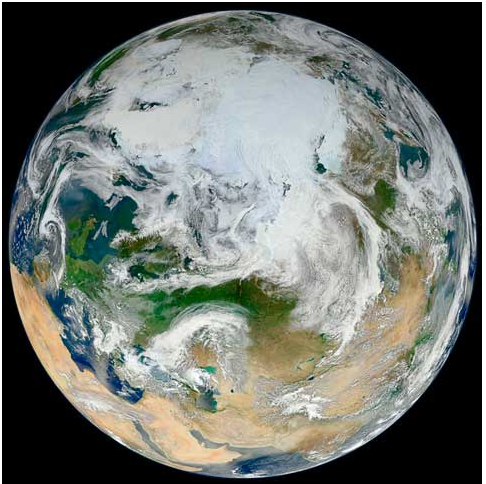The sun is up in the Arctic, and summer melt season is getting under way. Time to start watching the ice disappear, because the future of our planet is being written in the far north.
Before the internet, I used to start my day by reading the newspaper as I ate my tea and toast. These days I get my morning news fix from the web — but I can access so much more than just news. I can look down on the planet from space, and see what’s happening in the Arctic. NASA satellite photographs stitched together in near real time show with wonderful clarity what’s happening to the great sheet of sea ice that covers the Arctic Ocean.
It might sound like a strange obsession, but there are plenty of people watching the Arctic with considerable concern, from the scientists who study the place in all its glorious diversity, to interested amateurs like me. It’s like watching a slow motion train wreck — fascinating and dreadful at the same time. Arctic sea ice cover has changed dramatically in the last decade as warming has accelerated in the far north. Thick old ice that used to cover the majority of the ocean and last all through summer has disappeared, replaced by thin ice that cracks and melts easily. Last year’s sea ice minimum set a new record, only half of the normal ice cover for the time of year. This year’s melt season is starting with a thin cover of new ice. It has already started cracking and moving weeks ahead of schedule.
Will this summer bring a new record low? It’s of more than academic concern, more than just something happening somewhere on the other side of the world. The ramifications of the ice melt extend well beyond the Arctic. As the ice disappears, weather patterns around the northern hemisphere are showing signs of change. The polar jet stream, a ribbon of high altitude winds that circles the planet and marks the boundary between warm and cold air, has been behaving oddly. Weather systems get “stuck”, lingering for long periods in one place instead of steadily moving from west to east. Europe’s snowy late winter and early spring and last summer’s US heatwave are examples of the kinds of weather extremes that result.
Research teams are beginning to unpick the mechanisms at work as the climate system responds to Arctic change, but the reason is easy to understand. Heat is accumulating in the Arctic, melting more and more ice. There is now much more open ocean in late summer and early winter than was the case only ten years ago. As that ocean refreezes every winter, huge amounts of heat are released to the atmosphere. The pattern of northern hemisphere weather movements is driven by the difference between warm air coming up fro the south and cold air coming down from the north. As the Arctic warms, that heat difference decreases, and weather patterns change.
That’s bad news for North America, Europe, Russia and China, but the effects extend right down into the tropics — and perhaps further south. One recent study that looked at the potential impacts of a planet with a warming north pole and a south pole that stays cold (Antarctica is big and cold, and expected to stay that way for the foreseeable future), suggested that tropical rainfall patterns would shift northward as the difference between the hemispheres grows. That could have significant impacts on areas in the southern hemisphere left to dry out as the rains shift north.
What’s going on in the Arctic is rapid climate change, and it’s happening now. It’s changing the weather that most of the world experiences. It’s the most important and most visible of the multitude of climate impacts we’re forcing on the planet, and it’s worth watching every day. Will this year set a new record summer low for sea ice? It’s too early to call, but one thing is certain. Northern hemisphere climate has already changed, and will continue to change in ways we’re only beginning to fathom.
For comprehensive coverage and intelligent commentary, visit the Arctic Sea Ice Blog, and follow the data at the associated Arctic Sea Ice Graphs page.






It’s not necessarily bad news for Europe and Russia.
What is clear is that it poses challenges to adapt. The outcome might be bad or it might be good. We don’t know at this stage.
That’s right. All the flora and fauna on land and in the ocean in Europe and Russia (not to mention everywhere else) just has to evolve and adapt to a completely different climate within 50 to 100 years.
Gosmans climate denial is well recorded
If it is well recorded then it shouldn’t be any difficulty for you to produce then.
Perhaps Gareth would confirm it as I comment on his blog occasional. Gareth, have I ever denied the scientific evidence behind AGW ?
Perhaps not, but it’s safe to assume that you have always argued against taking meaningful action – or at least taken that side of any discussion.
Lol – oh Gosman. Remember your bold claims you were over on Gareth’s site ‘kicking arse’ back in the Tumeke days? Gosman, you are a climate denier in that you are a climate minimalist, just like Farrar. You always minimize global warming, that’s the new climate denialism. Only fools like Keeping Stock, Karl du Freeze , Mad Lord Monkton and Slater are outright deniers because the science and the evidence is rapidly mounting. Minimizing climate change is the fall back position for trolls like you and hard right masquerading as lite right spin master like Farrar.
Seeing the lies you post elsewhere on the blogosphere, I’m surprised you have the audacity to test my patience on this one.
The outcome “might be good”? If wishes were ponies, Gosman, you’d have a complete farm full of the expensive little plastic ones…
So far Europe seems to get harsh winters combined with drought in Summer in accordance with scientists predictions of this climate shift. So far none of that mounts any good news Gosman.
I am not sure what sort of tea you use to read the future from its leaves but I would personally stick with predictions made by reputable science institutes, and none of these are hinting at a ‘win situation’ for anybody arising from our changing climate.
It seems someone is denying my posts access to this thread and as such I am not able to respond to any comments directed towards me. You will have to have the debate with yourself.
No access. That’s good news. Long ago I got very tired of debating with uninformed idiots like you.
Of course, the irony is that ignorant pricks like you will be dead before the climate catastrophe gets into full swing……and with th4e effect of positive feedbacks results in a more or less uninhabitable planet by mid-century.
Why would you care about that, or care anyone other than yourself? Right?
Good outcomes for easier extraction of Arctic oil and gas resources? Good outcomes for shipping and trade along the Northern Passages? Good outcomes for the population struggling from bizarre weather patterns and rising inequality because they can “rely” on the elusive trickle down of wealth?
Far-right economics have no positive bearing on the environment or for that matter the lives of the majority of people. It’s incredible how the world is tolerating an ideology that is potentially rendering the Earth uninhabitable for a quick buck. If humanity manages to master interstellar space travel and occupy other worlds, I’m sure any alien civilisation will know where we’ve been by following the trail of trashed planets.
…!!!
You’ve.Got.To.Be.Shitting.Me.
I am gobsmacked at the sheer stupidity of that remark, Gosman.
Economist Richard Tol made a similar statement. Ie for warming up to 2 degrees, the outcome would be largely beneficial, then turn negative after that.
Tol is a lead author for the IPCC WG 2 I believe
Tol is in favour of strong action to reduce emissions.
How you value the impacts of climate change is an interesting question, and one that can be argued over almost indefinitely. How do you value the loss of the Arctic sea ice?
Most analyses have a big problem dealing with intergenerational equity. In the time taken to reach 2C warming (?50 years) we might avoid huge damaging impacts, but commit the planet to unavoidable sea level rise of 20m. The lucky generation (us) do well, but our children (‘s children’s children etc) are fucked. Whatever value you put on the present has to be outweighed by the one way nature of the changes we’re committing the planet to. This is not an economic argument, but economists who ignore it are doing the world a disservice.
As I said above, we are only just beginning to understand how the ice loss is impacting NH weather patterns, so making projections of future cost/benefit is more or less impossible.
You must remember that if some aspect of global warming is seen as good, then it is caused by nature. If some aspect of global warming is seen as bad, than it is caused by humans.
Just helping you out.
[…] column at The Daily Blog this week is all about ice — specifically the start of the melt season in the Arctic, and what that means for the […]
Gareth You said the ice was cracking weeks ahead of schedule, comparing your You Tube skit with this one http://www.youtube.com/watch?v=UaKqhRTqSlg it looks like it is several months ahead.
I’m guessing that’s because the ‘new’ ice isn’t as thick this year?
Hi Robert,
Take a look at the graphic in this post at the Arctic Sea Ice blog. It gives a very good picture of just how mobile the ice has been this spring. Someone there commented that March was looking very much like May…
First year ice is usually about 1.5 metres thick (± a bit), and I don’t know if this year’s is on the thin side or not, but the cracking and movement would suggest that it is. If that’s the case, then we could be looking at another big melt year…
Global mean surface temperatures have flatlined for the last 15 years or so. (Acknowledged by Pauchauri, Hansen, and even the MSM now)
Furthermore, many climate scientists are suggesting that climate sensitivity to CO2 is less than previously thought. For example, Nic Lewis’s latest peer reviewed paper has an average value of 1.6 degrees C
Temperature ≠ warming. And “flatlined” is not a good description of a period in which 2005 and 2010 were the warmest years in the record, and the 2000’s the hottest decade.
Climate sensitivity is a technical metric, and Lewis’ paper one more data point amongst many. But events in the Arctic render that sort of technicality moot, because the melt — and the resulting climate change — is running well ahead of any expectations.
In plain english, Gareth – Nic Lewis can postulate whatever he likes – right up until the waters are lapping at his doorstep…
Frank, are you claiming that scientific studies of climate sensitivity to CO2 have no value? (after all, this is what Lewis has published).
Judith Curry has written a fairly comprehensive post on the uncertainties in CS studies here:
http://judithcurry.com/2013/04/17/meta-uncertainty-in-the-determination-of-climate-sensitivity/
If you don’t think these studies have any value (in my view it is the central tenet of global warming theory), then I’d be interested to know why
Good on the Daily Blog for posting this!!
Keep up your great work 🙂
When the ice goes, and the science predicts 2015, then we will see the acceleration of warm followed sooner or later by submarine methane releases.
Then will will see our extinction in front of our noses.
NTE. Near Term Extinction. Currently expected some time between 2030 and 2080.
Metastable methane-ice clathrates are thought to total 3 times all the coal and oil on this planet.
“Metastable methane-ice clathrates are thought to total 3 times all the coal and oil on this planet.”
And I can’t wait to burn it all.
“Then will will see our extinction in front of our noses.”
Warm weather will cause our extinction? So that’s why people go to the tropics for a vacation every year, they hope to become extinct. If only they knew.
By the way, just to keep things in balance, the 2012-2013 meltdown of Antarctica has recently been reported as the greatest in a thousand years.
The good news is that the CO2 level will drop for the next six months, as northern trees start to photosynthesise. The bad news is it will be well over 400ppm this time next year, adding a bit more to the driver of the meltdown.
How many motor racing events will NZ host this year? Gotta get that sequestered carbon into the atmosphere!
Motor racing events in NZ are probably the least of your worries, it’s not the competitors you’ve got to worry about (10s to 30s), but the 100s of thousands of spectators. A motor race close a population centre generates far less emissions than a typical Tour de France stage.
However, as a petrolhead *and* northern hemisphere dweller I’m not in climate change denial; winters and summers in the UK have been getting worse for the last couple of decades, and I do what I can to minimise the damage to our planet.
Very nicely written, Gareth. You’ve said it all. And we all have to keep repeating it, unless natural variability helps the ice pack return to 1990’s levels. No sign of that though.
Thanks, Neven. Appreciated. As indeed is your excellent work at the Sea Ice blog and forum. I hope we’re both wrong…
[…] April 17, 2013 at 9:04 am […]
http://thiniceclimate.org/
Join us on Earth Day, April 22nd, 2013 for the global launch of Thin Ice: The inside story of climate science. The film will be available for free online here or can be seen in person at various screenings around the world from April 22nd-23rd.
From April 24th, 2013, the film will be available from our online shop, for a small fee.
Wellington Museum of New Zealand- Te Papa , at 18:00
Introductions by VUW Vice-Chancellor and British High Commissioner will be followed by a screening of the film and a panel discussion (30 mins).The panel will include the following individuals:
Chair: Finlay Macdonald- NZ writer/commentator, Auckland
Panellists: Dr. Nancy Bertler, a scientist in the film (VUW/GNS Science), Dr. Adrian Macey, former NZ Climate Change Ambassador (VUW) and Dr. Marc Wilson, Psychology lecturer (VUW)
This event is sponsored by Victoria University of Wellington and the British High Commission. The venue is provided by GNS Science. Please contact Michelle Dow for more information.
[…] in April, I discussed how warming in the Arctic and the dramatic reduction in sea ice was beginning to affect northern hemisphere weather patterns. The jet stream, which normally guides storms quickly from west to east across Europe, has become […]
[…] Watching the ice melt By Gareth Renowden – What’s going on in the Arctic is rapid climate change, and it’s happening now. It’s changing the weather that most of the world experiences. It’s the most important and most visible of the multitude of climate impacts we’re forcing on the planet, and it’s worth watching every day. https://thedailyblog.co.nz/2013/04/17/watching-the-ice-melt/ […]
Comments are closed.